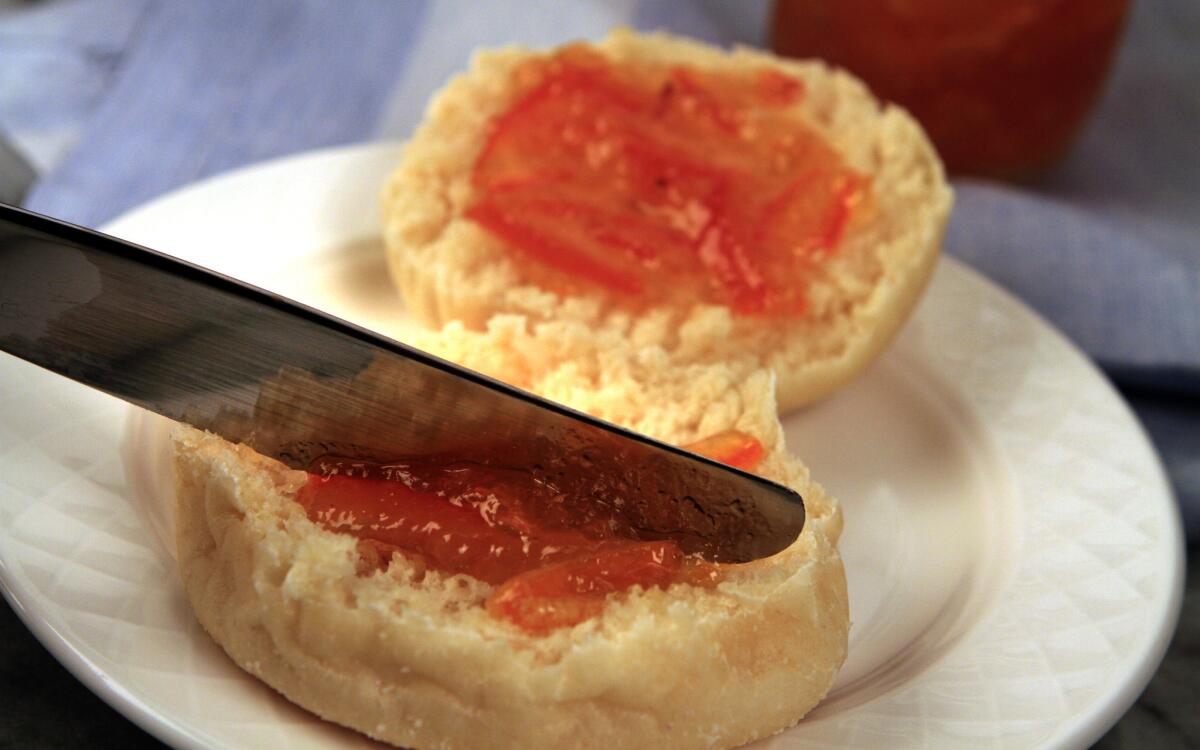English muffins

- Share via
A warm, freshly made English muffin has the subtle tang of yeast-risen dough and a golden-brown crust. Split it open and the crisp exterior gives way to the most delicate interior, light as air, yet slightly chewy, full of peaks and crevices -- those magical “nooks and crannies,” made even more magical when the muffin halves are toasted and all but drowned in butter or jam.
Sure, you can find the standard packaged varieties at your grocery store. Maybe you even know of a bakery that makes them from scratch. But have you ever tried to make them yourself? It’s not as hard as you might think, and there is nothing like the flavor of a muffin fresh off the griddle.
Do a search for English muffin recipes and you’ll come up with a wide range of results. Recipes for English muffins run the gamut from firm doughs (such as for breads) to spoonable batters (as if you’re making pancakes).
While most muffins are cooked on a griddle, some recipes offer the option of baking them in the oven. Form each as you might a classic dinner roll, or shape them using muffin rings or a biscuit cutter.
Even the ingredients vary from recipe to recipe. Some are simple, calling for flour, yeast, sugar, salt and water or milk. Others substitute buttermilk for the milk, or cornstarch for some of the flour. Some even add eggs.
And though most English muffin recipes call for a yeast-leavened dough, some add a touch of chemical leavener -- baking soda or powder -- to lighten the final product.
I tried a number of recipes, testing dough and batter methods and playing with a number of ingredients. In the end, I found that the recipe didn’t need to be complicated at all.
Some bread flour, a touch of sugar, salt and yeast will get you started. Whisk in a little melted butter and enough milk to form a very soft dough -- extra liquid helps to give the muffins their airy texture. Most of the dough-based recipes I found contained too little liquid; while the dough might bake up fine for dinner rolls, it was too dense and tough for a light English muffin. Conversely, while the batter-based recipes I tested cooked up light, the results looked and tasted more like pancakes than English muffins.
Make the dough ahead of time -- up to a day in advance -- refrigerating it so it rises slowly, giving the yeast time to work and develop better flavor. Then divide the dough, rolling each portion in cornmeal and flattening into a disk to rise again.
To cook the muffins, gently heat a griddle over low heat (the crust and texture simply isn’t the same if they’re baked in an oven). Because you’re cooking on a stove top, the flame needs to be set so the muffins will have just enough heat to bake through as the crust forms; if the griddle is too hot, the crust will burn before the muffins are cooked. Check the first few muffins frequently to make sure the heat is just right. When the muffins are cooked on one side, gently flip them over to continue cooking the other side. (Some recipes offer the option of baking the muffins in an oven, but they lack the crust and texture of a classic English muffin.)
Much as you might be tempted to eat them immediately, cool the muffins on a rack for at least a few minutes before serving.
Don’t cut them open with a knife. Pierce the delicate sides of the muffin with the tines of a fork, slowly working your way around the outside edge. Then gently pull apart the halves to properly reveal all the nooks and crannies. Slather with some butter or jam, and you’re bites away from pure bliss.
In the bowl of a stand mixer, whisk together 3 1/2 cups (15.75 ounces) of the bread flour, sugar and yeast.
Switch to the paddle attachment. With the mixer on low, slowly beat in the melted butter, followed by the milk to form a soft dough. Switch to the dough hook attachment, and beat in the salt. Continue mixing the dough, adding additional bread flour 1 tablespoon at a time until the dough is smooth and just begins to pull away from the sides of the bowl, about 7 minutes on medium-low speed (you may not need to add all of the flour). At this stage, the dough will be firm yet moist and somewhat sticky.
Turn the dough out into a lightly oiled large bowl. Cover the bowl with plastic wrap and refrigerate overnight (this slows the proofing process and allows the flavors to develop).
About 2 hours before cooking, remove the dough from the refrigerator, punch it down and set it aside to come to room temperature.
Place the cornmeal in a medium bowl. Using greased hands, divide the dough into 12 even portions, about 2 3/4 ounces each. Gently form each portion into a ball, and roll the balls in the cornmeal to lightly coat on all sides. Working with one ball at a time, flatten each ball into a disk about 3 1/2 inches in diameter and one-half-inch thick. (If the dough starts to spring back, set it aside and move onto the next ball to give the dough time to relax). Place the disks on a lightly greased parchment-lined baking sheet.
Place the sheet in a warm place until the disks are puffed and risen to about 1 1/2 times their original height (watch that the disks do not over-proof or they will flatten as they bake), 15 to 30 minutes.
Heat a griddle or a cast iron skillet over medium-low heat (don’t heat the griddle too hot or the English muffins will brown before they are fully cooked on the inside). Very lightly grease the griddle, then gently place the muffins on the griddle, leaving a little space between each one so you have enough room to check them and flip them as needed.
Cook the muffins on one side for 5 to 8 minutes until set and lightly browned, and the muffins have risen. Using a metal spatula, gently flip each muffin to cook on the other side. Do not press the muffins down as you flip them or they will flatten; simply leave them to cook. Continue to cook the muffins until the other side is set and lightly browned, about 5 minutes more.
Cool the muffins on a rack before splitting and serving.
Get our Cooking newsletter.
Your roundup of inspiring recipes and kitchen tricks.
You may occasionally receive promotional content from the Los Angeles Times.
















